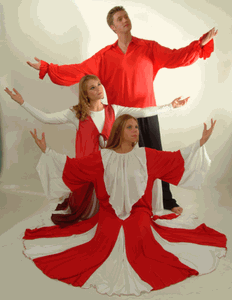
These are available from a company with which I had to transact business (we had to outfit a Don-Jose-goes-into-the-mountains drum major). Having never actually seen L.D., I thought the movement had given up the ghost, but apparently it's alive and well somewhere. I find it intersting that most of the items for sale seem to be made of polyester. I also find it interesting that I didn't see a model who could have been alive when all this craziness began.
My favorite quotes:
Your dancing is a form of praise and you should look your very best!
A liturgical basic that meets so many of your performance needs!


At least the girl in the red pant-dress is young, pretty, and apparently happy. I understand that most Catholic liturgical dancers are none of those things. But I wouldn't know, since I live in the rigid, oppressive, legalistic Arlington diocese, where we put liturgical dancers in the Iron Maiden if they start waltzing down our naves.
I defy anyone to look at this outfit without laughing.
And those Iron Maidens are REALLY hard to dance in!! :)
Anyone else think they look like jesters?
Whatever happened to ethereal gossamer white?
If you are going to do Christian dance, at least have outfits that are vaguely symbolic of what you are dancing about.
Let's hope that Catholics are a very small (say, zero) percentage of their liturgical dancewear customer base.
I wonder if there's a Salome outfit?
Eric,
That LAST thing I, or anyone in their right mind, wants to see is Sr. Orbis Rotunda doing the Dance of the Seven Veils at Mass! Don't give them ideas!
Since liturgical dancing is a recent innovation, they'd have to update the dance, too. Salome could say, "Bring me the head of John the Schultz!"
Liturgical dancing is not a new thing.
I recall a certain king of the Hebrews by the name of David doing so. And a book of Psalms chock full of reference to dancing before the Lord. But oh well.
That's not liturgical, Ken, that's just dancing. I'm no expert on the subject, but I've never read that dancing was ever part of the Jewish liturgy. (As ever, I am open to correction on that point.)
For Catholics, liturgical dancing is new and prohibited in Western countries, because dancing is almost exclusively secular and usually erotic. In Africa, where dancing is a traditional part of worship, it's allowed because it doesn't have the same baggage.
Perhaps we can encourage parishes (or individuals) that have an extra 56 bucks ("add $9.60 for size XXXL) to spend on a "Velvet Liturgical Tunic" to send the money to Africa instead. I know some missionary sisters who would be very grateful to have it.
Incidentally, I'd just as soon pass on seeing anyone who needs size XXXL in "dancewear."
Mio, didn't you ever see "Fantasia"? The part with the ballet-dancing hippos? That's what I'm picturing.
What I find disturbing is how reminicent those robes are of the robes worn in the movie "A Handmaiden's Tale"- not exactly an association I would recomend the Church to pursue
In the Arlington Diocese, "The Handmaid's Tale" is banned, and the chancery has issued a fatwa against Margaret Atwood.
Oooooo, I want that outfit Eric posted in an XS. I've been looking for a smock like that for Hambet when he paints.
That outfit on the front page was quite a doozy, too. I once saw an outfit like that on a vintage photo of Twiggy.
Well said, Eric. You nailed the simple, elegant explanation for why liturgical dance is verbotten in the West.
And the "Bring me the head of John Schultz" line was very funny. And not even scary.
Last night I had the strangest dream. I dreamt that the Roman Catholic Church traded in all our communion rails and Italian statues for this guy .
That was a dream, right??
Last night I had the strangest dream. I dreamt that the Roman Catholic Church traded in all our communion rails and Italian statues for this guy .
Wasn't he on Star Trek: TOS (with the outfit and all)?
Eric:
What is this "Hand-Maiden's Tail" book of which you speak? I have never heard of it. If it is a book, and it agrees with Bishop Loverde's Red Book, then it is redundant, and should be burned. If it is a book, and it doesn't agree with Bishop Loverde's Red Book, then it is blasphemous, and should be burned.
Last night I had the strangest dream. I sailed away to China. In a little row boat to find ya. And you said you had to get your laundry clean.
He's a liturgical dancer? Oh. For a minute I thought he was one of those TFP guys on parade.
Dear all:
Ah, liturgical dance. As Scotty would say in Star Trek: The Voyage Home (or Kirk and Spock Save the Whales): 'How quaint.'
Perhaps the best of the best of that sort of thing can be found in Karl Orff's Carmina Burana. It even has the advantage of having extensive mediaeval texts sung in Latin. However, that lovely little exercise in creative anachronism was perhaps the nearest that the Western church has come to an authentic liturgical dance (or LD). Too bad for advocates of LD that it was begun during Nazi-occupied Germany, and always performed outside the church.
From an Eastern perspective, however, perhaps the main objections Orthodox and Eastern Catholics have toward it are that Western LD is a performance art which does not involve the people, and that it is too fast.
In the Eastern and Western Churches until quite recently, we had liturgical gestures and movements which were (and at least in the East) still are a kinesthetic part of our worship: the sign of the Cross; bowing at the name of Jesus or the Trinity; genuflection; full prostrations (especially during Lent); and slow processions with singing at Feasts (particularly Pascha), at baptisms, and at weddings. Regarding the last, if you have ever seen the movie, My Big Fat Greek Wedding, you will have seen the procession, at the point where Toula says to her new husband, Ian: "This is where we are married: we're taking our first steps together as husband and wife."
If anything, it is even more beautiful in the Russian tradition, where the priest walks slowly backwards, leading the new husband and wife together in a circle, while the choir and congregation sing the hymn "Rejoice, O prophet Isaiah". As a matter of fact, this part of the Orthodox wedding service is traditionally called "Isaiah's dance".
Oh, yes, and we also have garments that at least some of those who take part in liturgical gestures wear. They're called vestments.
My suggestion to those who wish to restore liturgical gesture (as opposed to LD), is that they might want to look at what gestures and movements have been used in Eastern and Western liturgical tradition, and to restore their use among the clergy and the people. At least that way, they won't look as mannered, as goofy, and as ridiculous as some of these "sacred showboaters" (my term for performance liturgical dancers) have managed to make themselves look.
Sorry, the comment incorrectly recorded my weblog address. The correct one (I hope) should be here. If not, you can read me at http://pauca_lux_ex_oriente.blogspot.com
Thanks, Bernard.
It's only fitting that Carmina Burana isn't performed in churches; the texts are satirical medieval songs, right?
I dunno -- "O Fortuna, Imperiatrix Mundi" is from Boethius, isn't it? I don't have the strength this evening to type it into the Google toolbar to confirm that.
I read about an apparently orthodox Jesuit who is trying to promote liturgical dance outside the Mass, to reclaim dancing as a sacred expression of faith. He made it absolutely clear that dancing had no place in the Mass. I suppose if our culture changed, then liturgical dancing (or more liturgical gesture, at any rate) could be incorporated, but that will take a long time.
Wow! "O Fortuna" penned by Boethius himself. That would be nice, if true. Boethius the first of the Goliards!
Unfortunately, I can't find anything that would substantiate that. The nearest is that Boethius, in his Consolations of Philosophy, basically coined the image of the "Rota fortunae", or "wheel of fortune". Pity that he can't collect royalties on the TV Game, Wheel of Fortune.